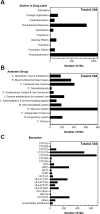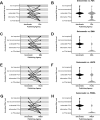Pharmacogenetic information in Swiss drug labels - a systematic analysis
- PMID: 33070160
- PMCID: PMC8292148
- DOI: 10.1038/s41397-020-00195-4
Pharmacogenetic information in Swiss drug labels - a systematic analysis
Abstract
Implementation of pharmacogenetics (PGx) and individualization of drug therapy is supposed to obviate adverse drug reactions or therapy failure. Health care professionals (HCPs) use drug labels (DLs) as reliable information about drugs. We analyzed the Swiss DLs to give an overview on the currently available PGx instructions. We screened 4306 DLs applying natural language processing focusing on drug metabolism (pharmacokinetics) and we assigned PGx levels following the classification system of PharmGKB. From 5979 hits, 2564 were classified as PGx-relevant affecting 167 substances. 55% (n = 93) were classified as "actionable PGx". Frequently, PGx information appeared in the pharmacokinetics section and in DLs of the anatomic group "nervous system". Unstandardized wording, appearance of PGx information in different sections and unclear instructions challenge HCPs to identify and interpret PGx information and translate it into practice. HCPs need harmonization and standardization of PGx information in DLs to personalize drug therapies and tailor pharmaceutical care.
© 2020. The Author(s).
Conflict of interest statement
The authors declare that they have no conflict of interest.
Figures






References
-
- Dingermann T, Zündorf I Stratifizierte Pharmakotherapie: Genetische Grundlagen, praktisches Vorgehen. Govi-Verlag, 2017.
Publication types
MeSH terms
Substances
LinkOut - more resources
Full Text Sources
Medical

